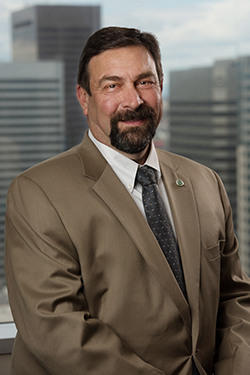
For our hybrid meeting on July 28, CSU System Chancellor Tony Frank gave us a detailed introduction to the philosophy, goals and design of the CSU Spur campus currently under development in downtown Denver. He started by focusing on the physical plant which will consist of three buildings: Vida (focused on human and animal health), Terra (food and agriculture) and Hydro (water). Then he launched into a detailed summary of the educational and physical background in the state of Colorado that led to the Spur concept.
In terms of the location and extent of the physical plant, Dr. Frank started with the advent of the National Western Stock Show in 1906 on the north side of downtown Denver. Over the years, with construction of the Denver Coliseum, the Events Center, and the Hall of Education, along with the rail yards, the “improvements” of the South Platte River, the presence of two large sewage lines on the NW side of the complex, and the construction of Interstate 70 right through the middle of the complex, historic immigrant neighborhoods were divided and isolated from each other. With the ageing of the facilities, there was a move to relocate the National Western complex to some more convenient or appropriate location. However, given the size of the available site, its location in the population center of the state, the already-existing light rail connections, and the availability of large facilities that could be renovated or repurposed to provide the heart of the desired venue, it was decided to keep the complex in its historic location but to upgrade and expand the facilities to make a more widely useable and attractive year-round venue for the future. Thus arose the current plan including significant funding from the state, the city of Denver, and private enterprise. Could CSU fit into that vision?
To establish CSU’s justification for participation in the project, Dr. Frank pointed to several trends in the state. In terms of the state’s population and resources, a small and decreasing portion of the population is involved in food production while the urban population (those who have no connection with food production) is dramatically increasing. At the same time, global trends in decreasing food and water, increasing urbanization and energy use, and decreasing airquality pose global challenges. thThese problems are ready-made to be addressed by a land-grant university. But on the education front, some 78% of the high-school graduates in the state do not meet readiness standards for college. Of high-school graduates a discouragingly high percentage either do not attend college or start but never finish. For Hispanic and other minority students, these statistics are even worse. At least part of the problem is that attitudes about going to college are well-established by the first year or so of high school. This in spite of the fact that a college education is one of the best possible investments to make. What can, or should, CSU be doing to address these issues?
Dr. Frank, a biologist by academic training, pointed to the well-recognized benefits of edge ecosystems, where different ecosystems border and interact with each other resulting in dramatic improvements in productivity and diversity. The plan for the Spur campus is to provide that sort of interaction of different “ecosystems” (e.g., STEM to rural, multi-national, multi-cultural) to inspire and engage the youth of Colorado, to make learning fun, and to instill the idea of going to college in both kids and their parents at an early age. The idea is that all three of the CSU Spur buildings (Vida, Terra, and Hydro) will include wide-ranging activities where K-12 kids can participate in interesting and fun academic activities, whether for half a day on a school trip or for a longer span as what might be called interns. In Vida, they might be able to see a vet clinic or equine sports medicine in action. In Terra, they might be able to see and participate in urban agriculture innovation and research in action. In Hydro, they might be able to see and participate in activities related to waste-water management or innovation or research in better use of water (part of which is the effort to ultimately get rid of the idea of buy and dry of agricultural land to provide water for urban development).
Building is already in progress for the Spur campus. The buildings are designed to meet the LEED Gold Standards. The expectation is to participate in and contribute to the Forum on One Water. Plans even include use of the heat from the sewage lines on the NW side of the area to provide energy for the complex. Activities are to include community-engaged research. One of the objectives is to provide science for the world.
In response to questions:
What are the prospects of jobs in the arena of global warming and will Spur contribute to that? Will there be degrees from Spur? What are the prospects and plans for interface between Spur and K-12 children?
Spur will not offer any degrees but rather will be focused on outreach to encourage children and their parents to aim for higher education in places like CSU. With degrees from places like CSU, there will probably be global-warming encouraged jobs in energy systems, agricultural systems, and even various businesses that address the issues associated with global warming.
The expectation is that the Spur system/experience will become embedded in the K-12 curriculum such that a student might expect to have a beneficial Spur experience on the order of twice per year – 24 times over the span of his/her K-12 learning experience.